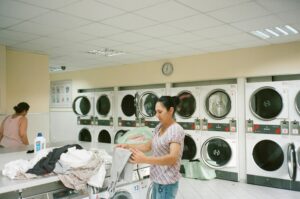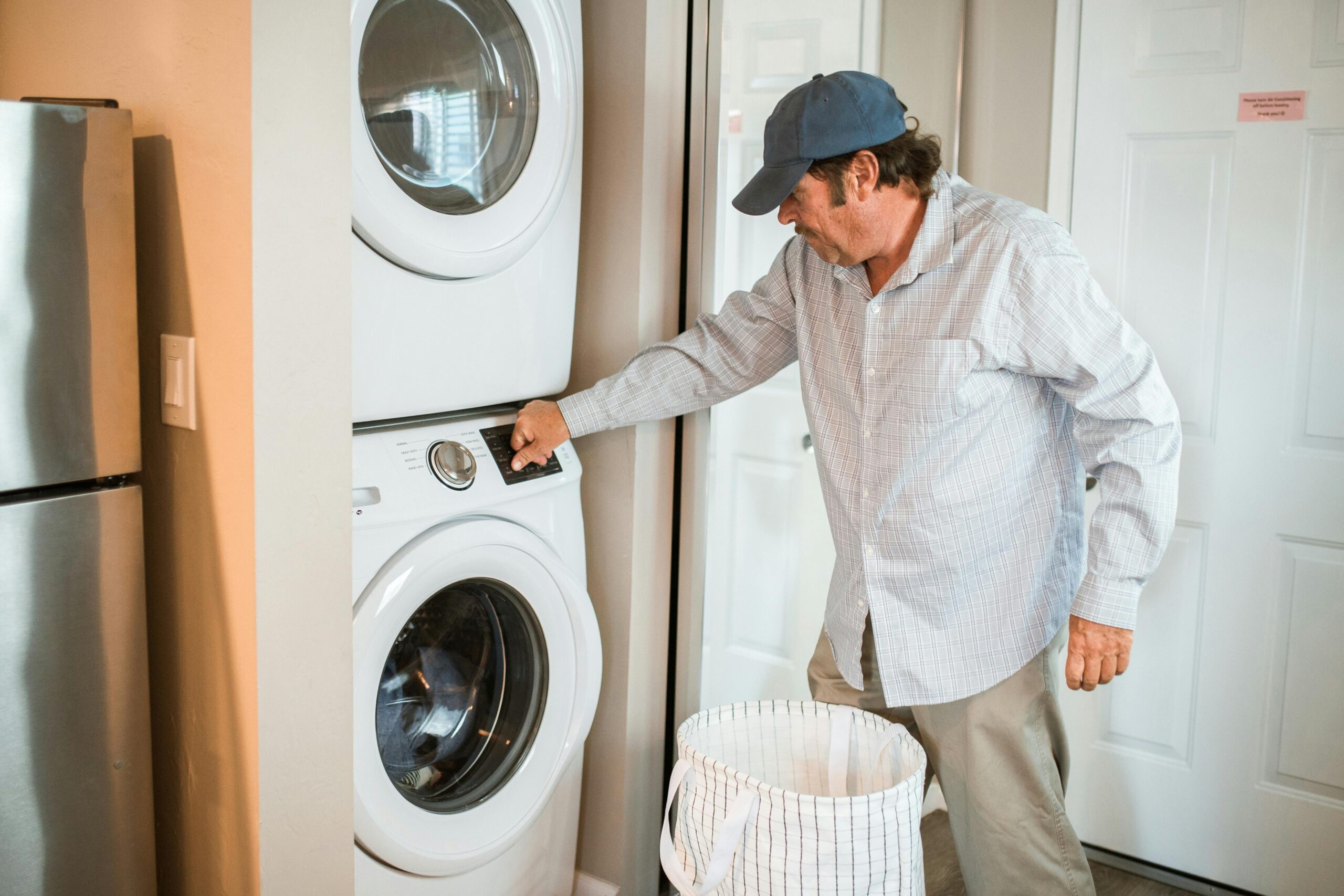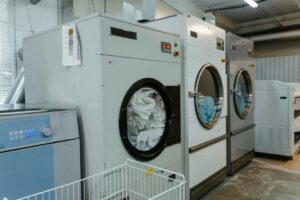Is a how to start a laundromat business?
A laundromat business provides self-service washing and drying machines for customers who don’t have access to laundry at home. It’s a utility-based service that thrives in both residential and urban areas. Some laundromats also offer added services like wash-and-fold, dry cleaning, or pickup and delivery.
Absolutely—especially if you’re new to the industry. A well-structured “how to start a laundromat business“ guide offers a clear roadmap, including:
-
How to assess the market and choose a profitable location
-
What licenses and permits are required
-
How much money you’ll need to start
-
What equipment to buy and where to get it
-
How to market your laundromat
-
Common pitfalls and how to avoid them
These guides help you avoid costly mistakes and move forward with confidence.
Key Benefits of Starting a Laundromat Business
Here’s why so many people consider starting a laundromat:
-
Recurring income – People need clean clothes regularly.
-
Low labor needs – Many laundromats run with little to no staff.
-
Flexible hours – Can be open 24/7 depending on the area.
-
Scalable – Once successful, you can open multiple locations.
Challenges to Consider
While a laundromat can be profitable, it’s not 100% passive. Some things to keep in mind:
-
Startup costs can range from $100,000 to $300,000+
-
Maintenance is ongoing—machines break down and need repairs
-
Utilities like water and electricity are a big part of your overhead
-
Competition can impact your profit margin
A good how to start a laundromat business guide will help you plan for these factors.
Is It the Right Business for You?
This business suits you if:
-
You’re financially prepared for upfront investment
-
You want a business that doesn’t require constant supervision
-
You’re good at managing systems and solving problems
-
You’re looking to build long-term, stable income

It may not be ideal if you want instant profits or dislike handling repairs and customer issues.
What is a laundromat business?
A laundromat business is a self-service facility where customers pay to use commercial-grade washers and dryers to clean their clothes. Customers typically bring their own laundry supplies, although many laundromats also offer detergent, softeners, and dryer sheets for sale.
The laundromat owner provides and maintains the machines, ensures the facility is clean, and manages operations. Some laundromats are fully unattended, while others have staff on-site to assist customers or offer extra services like wash-and-fold or pickup and delivery.
Key Features of a Laundromat Business
Understanding the key features helps clarify what makes a laundromat business different from other service-based businesses:
-
Self-service model – Customers operate the machines themselves.
-
Recurring demand – People always need clean clothes, creating steady foot traffic.
-
Cash or card payment systems – Machines accept coins, loyalty cards, or mobile apps.
-
Minimal labor – Many laundromats operate with little to no staff.
-
Open hours – Often open early or 24/7, especially in high-demand areas.
Types of Laundromat Services
While the traditional laundromat focuses on self-service, many businesses expand into additional services, including:
-
Wash-and-fold – Staff wash, dry, and fold customer clothes.
-
Dry cleaning drop-off – Partner with dry cleaners for extra revenue.
-
Pickup and delivery – Offer convenience to busy professionals or families.
-
Commercial laundry – Serve local hotels, gyms, or salons.
These extra services can help increase income and customer loyalty.
Why Start a Laundromat Business?
There are several reasons why people consider starting a laundromat business:
-
Stable income – Laundry is a basic need.
-
Passive potential – With automation, it can be semi-passive.
-
Simple operations – No complex inventory or perishable goods.
-
Scalable model – Expand to multiple locations once profitable.
-
Recession-resistant – People do laundry regardless of the economy.
Who Uses Laundromats?
A laundromat business serves a wide range of customers, including:
-
People who live in apartments without washers or dryers
-
Tourists and short-term renters
-
College students
-
Small businesses (like salons or massage clinics) needing clean linens
-
Busy professionals who opt for wash-and-fold services
Understanding your local audience is key to choosing the right services and location.
How to start laundromat (launderette) business?
1. Understand the Laundromat Business Model
Before investing, get clear on what a laundromat business involves. Customers pay to use commercial washers and dryers. Some businesses also offer value-added services like:
-
Wash-and-fold
-
Pickup and delivery
-
Dry cleaning drop-off
-
Vending machines or ATM services
This is typically a self-service or semi-passive income model that requires smart planning and location choice.
2. Conduct Market Research
Knowing your target audience and competition is crucial. Analyze:
-
Local demographics (students, renters, tourists?)
-
Competitor laundromats—services, hours, pricing
-
Residential density (high foot traffic = better ROI)
Use this research to decide if your area can support another laundromat.
3. Create a Business Plan
Your business plan should include:
-
Startup costs & funding strategy
-
Monthly operating costs (rent, utilities, maintenance)
-
Revenue goals
-
Marketing strategy
-
Equipment and staffing plan
A clear plan not only helps you stay organized—it’s also essential if you’re seeking financing or a loan.
4. Choose the Right Location
Location is everything in the laundromat business. The best places:
-
Are in high-traffic areas
-
Have little or weak competition
-
Are near apartment buildings or student housing
-
Offer easy parking and visibility
5. Get Licenses, Permits & Insurance
Make sure you meet local regulations. Common requirements include:
-
Business license
-
Health and safety inspection
-
Fire and utility permits
-
Commercial insurance (liability, property, workers’ comp if you hire staff)
Check your city’s website or consult with a small business advisor.
6. Buy Equipment and Set Up the Space
Invest in commercial-grade washers and dryers. Depending on your budget, you can buy:
-
New machines with warranties (higher upfront cost, lower maintenance)
-
Refurbished machines (lower cost, but more upkeep)
Also consider:
-
Payment systems (coin, card, or app-based)
-
Folding tables, seating, carts
7. Hire Staff (If Needed)
Many laundromats operate unattended, but some hire:
-
Attendants for customer service
-
Cleaners to maintain hygiene
-
Delivery drivers (for pickup/drop-off services)
The decision depends on your business model.
8. Market Your Laundromat
Before launch, spread the word:
-
Use Google My Business
-
Promote on social media and local ads
-
Offer grand opening discounts
-
Partner with nearby businesses
A clean, well-lit, and customer-friendly laundromat will retain loyal clients.
9. Launch and Monitor
Open your doors and monitor the performance. Track:
-
Peak hours and machine usage
-
Customer feedback
-
Operating costs vs. income
-
Maintenance needs
Use this data to adjust hours, pricing, or services as needed.
Final Thoughts
Knowing how to start a laundromat (launderette) business is the first step toward building a reliable, cash-generating venture. With the right planning, location, and services, your laundromat can serve your community while providing long-term returns.
What information do I need to start a laundromat?
How can you start a laundromat for free?
1. Seek an Investor or Business Partner
One of the most effective ways to start a laundromat for free is by finding an investor or silent partner. They fund the initial costs, and you provide the labor, management, and sweat equity.
What to offer:
-
A clear business plan
-
Profit-sharing agreement
-
Regular financial reports
2. Buy an Existing Laundromat with Seller Financing
Some laundromat owners want to retire or move on. They may offer seller financing, allowing you to pay for the business over time using the laundromat’s revenue.
Benefits:
-
No large down payment required
-
Business may already be profitable
-
No need to build from scratch
3. Use a Lease-to-Own Equipment Agreement
Instead of buying expensive machines upfront, negotiate a lease-to-own deal with laundry equipment suppliers. Some vendors allow you to pay monthly and own the equipment after a set period.
Tips:
-
Look for flexible payment plans
-
Ask about zero-down promotions
-
Ensure equipment includes maintenance
4. Apply for Grants and Small Business Competitions
While rare, small business grants, especially for minority, women, or veteran-owned startups, can help cover some costs. Local economic development agencies may also offer incentives to open in underserved areas.
Where to look:
-
SBA.gov
-
Local Chamber of Commerce
-
Startup competitions or pitch events
5. Partner with a Property Owner
If you find a commercial space with unused plumbing or an old laundromat setup, the landlord might be willing to co-invest or offer rent concessions if you agree to operate the business.
This works best when the laundromat will bring foot traffic to other tenants or increase the value of the property.
6. Start with a Small Mobile Laundry Service
Another creative route: start a mobile laundry service (pickup and delivery) to build a customer base and income. As profits grow, use the funds to invest in your own laundromat location.
Start-up needs:
-
Washer/dryer at home or rented
-
Car or van for delivery
-
Online booking system
How much does it cost to start a laundry business?
1. Startup Costs Overview
The average cost to start a laundry business ranges from $75,000 to $500,000 or more, depending on the scale and whether you’re opening a self-service laundromat, a drop-off laundry service, or a mobile )
2. Breakdown of Common Expenses
✅ Location Lease or Purchase
-
Lease deposit & initial rent: $5,000 – $20,000
-
Buying a property: $150,000+
✅ Renovation & Plumbing
-
Plumbing, electrical work, tile, ventilation: $10,000 – $100,000
-
ADA compliance and permits add extra costs.
✅ Laundry Equipment
-
Commercial washers and dryers (8–20 machines): $50,000 – $250,000
-
Folding tables, carts, coin changers, soap dispensers: $5,000 – $15,000
3. Licensing and Legal Fees
-
Business license, permits, inspections: $500 – $2,000
-
Legal fees for forming an LLC or business entity: $500 – $1,500
4. Marketing and Branding
-
Website, logo, signage, opening ads: $2,000 – $10,000
-
Grand opening promotions or referral programs
5. Utilities and Insurance
-
Utility deposits: $2,000+
-
Water, gas, electricity monthly: $1,500 – $5,000/month depending on volume
-
Business insurance: $1,000 – $2,500 annually
6. Optional Expenses
-
Staff wages (if not self-service): Variable
-
Laundry software or payment systems: $1,000 – $5,000
-
Surveillance cameras, seating, vending machines
7. Low-Budget Alternatives
If you’re asking how much does it cost to start a laundry business with limited capital, consider:
-
Starting with a mobile laundry service for under $10,000
-
Buying a used laundromat with equipment included
-
Leasing equipment instead of purchasing upfront
Conclusion: Getting Started with a Laundromat Business
Starting a laundromat business can be a rewarding and profitable endeavor, but like any business, it requires careful planning, investment, and strategy. From understanding the costs involved, such as location, equipment, and utilities, to exploring creative options for financing, you can take steps to ensure a smooth launch. Whether you choose to start small with a mobile laundry service or dive into a larger-scale laundromat operation, there are various pathways to success.
By doing your research, building a solid business plan, and considering innovative funding options, you can create a sustainable laundromat business that meets the needs of your community. With the right mindset and resources, you’ll be well on your way to becoming a successful business owner in the growing laundry industry.
The key is to stay focused, adapt to customer needs, and manage costs effectively. Once you’ve laid a strong foundation, the potential for long-term profitability in the laundromat business can be significant.






edegxx